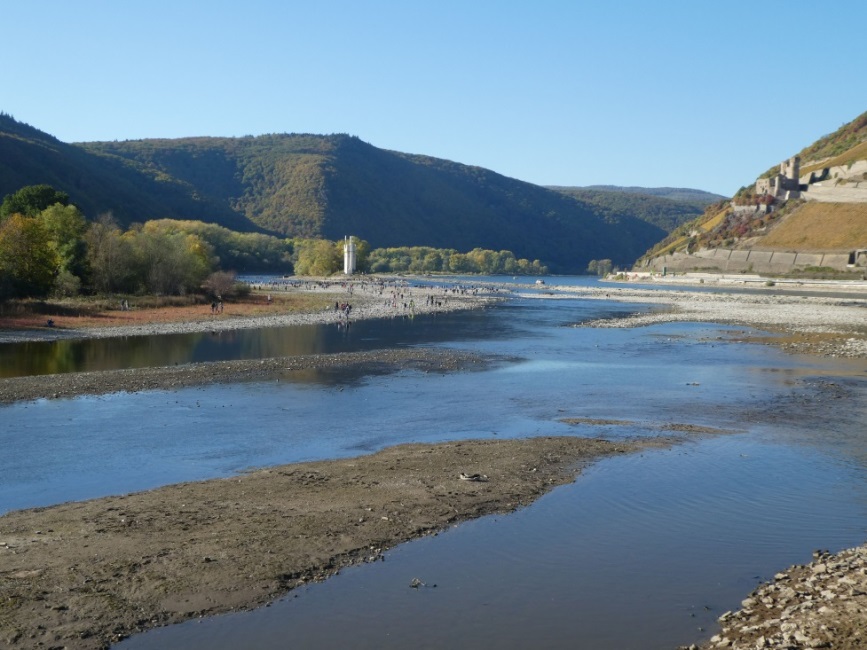The persistent drought of this summer in Switzerland, Germany and the Netherlands has significantly reduced the water levels of the rivers. For example, the discharge of the Rhine at the Basel-Rheinhalle gauging station is well below average: the amount of water currently flowing past Basel is less than half of the long-term average for October. In Germany and the Netherlands, a comparison with the long-term monthly average is even more unfavourable: discharge here is only about 40 percent of what is normal for this time of year.

Estuary of the Nahe with extreme low streamflow of the Rhine near Bingen in October 2018. In the background the Mäuseturm and Burg Ehrenfels (Photo: Dr. K. Wendling/MUEEF-RLP)]
Given the current low water levels, the importance of the glaciers in the Alps for the hydrological situation of the Rhine catchment is becoming increasingly apparent. Especially with extremely low water levels, the meltwater of the glaciers contributes significantly to the water level of the Rhine. The CHR has therefore commissioned a Swiss-German research consortium to study the component of meltwater from snow and glaciers in the discharge of the Rhine and its tributaries in the Alps. This is a follow-up to the CHR study published in 2016, in which the proportions of the discharge components for the period from 1901 to 2006 were already shown on a daily and monthly basis.
High proportion of meltwater in dry conditions
During the hot summer of 2003, for example, a maximum proportion of 20 percent glacier meltwater was found in the discharge at the Kaub gauging station in Germany, an important gauging station for shipping. Without that amount of meltwater, the water level in the narrow channel of the Middle Rhine Valley would have been even 28 centimetres lower. In the German-Dutch border area near Lobith, the maximum meltwater level on 28 August 2003 was still 17 percent. These figures are based on the hydrological models used in the project, some of which were newly developed for the international Rhine basin. Values for the current situation are not yet available; however, in 2018 the meltwater level is estimated to be slightly lower due to the decreased volume of the glaciers.
More detailed explanations on future developments
Based on the available data, only the historical low water events up to 2006 were analysed in the first project phase. The second phase (2018-2021) now also examines more recent low water periods. In this research, current climate projections and associated hydrological models will be used. This should allow making more detailed statements on the future development of glaciers and on glacier and snow runoff from meltwater in the Rhine catchment, taking into account global climate change.
Effects of the disappearance of glaciers
Due to the prolonged and above average heat this summer and autumn, glaciers in Switzerland lost around 1,400 million cubic metres of ice just in 2018: a drop of 2.5%. Without the enormous amounts of snow last winter, this melting of the ice would have been even more dramatic. After several extremely hot years, glaciers have lost as much as one-fifth of their volume since 2008, as reported by the Cryospheric Commission of the Swiss Academy of Sciences (SCNAT) in mid-October. The new CHR study should also show how glacier retreats affect Rhine discharge in Switzerland, Germany and the Netherlands.
Information
Petra Schmocker-Fackel, Federal Office for Environment FOEN (Bern, Switzerland; Project management), petra.schmocker-fackel@bafu.admin.ch; Tel +41 58 46 476 66
Peter Krahe, Federal Institute of Hydrology BfG (Koblenz, Germany) , Section M2 – Water Management, Predictions and Forecasts: krahe@bafg.de; Tel +49 261 1306 5234
Jörg Uwe Belz, Federal Institute of Hydrology BfG (Koblenz, Germany) , Section M1 – Hydrometry and Water Management Consultancy: Belz@bafg.de; Tel +49 261 1306 5428
Eric Sprokkereef, Secretariat International Commission for the Hydrology of the Rhine Basin CHR Department of Public Works and Water Management WMCN (Lelystad, Netherlands): eric.sprokkereef@rws.nl; Tel + 31 88 7985 233
Links
Synthesis report of the first phase of the project:
English: https://chr-khr.org/en/file/1057/download?token=Zg6SY04i
German: https://chr-khr.org/de/file/1058/download?token=syGnLweH